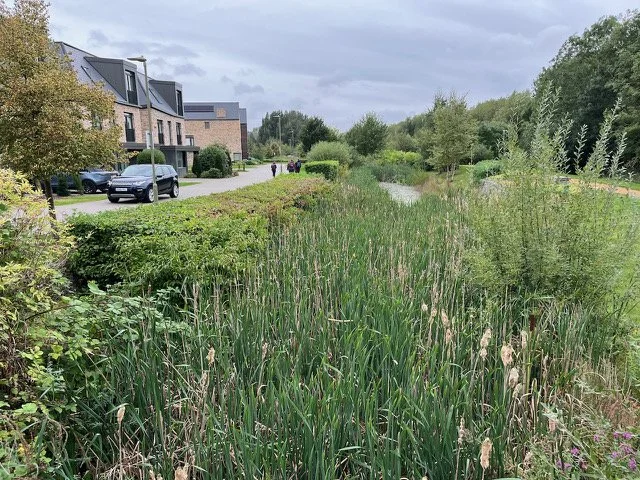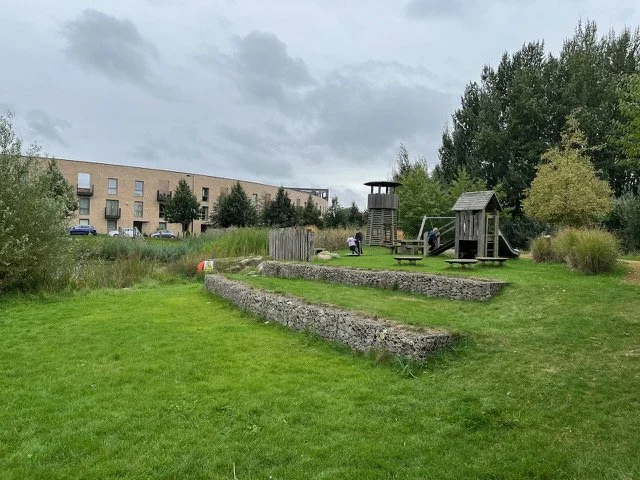Maximising the Landscape, Ecological and Amenity Value of Sustainable Drainage Systems (SuDS)
The 2025 update to the National Standards for Sustainable Drainage Systems (SuDS) formalises expectations once seen as best practice and provides an important change in how surface water runoff should be attenuated and managed within new developments.
This article summarises the new standards and advises how landscape-based SuDS - such as rain gardens, swales, green roofs and wetlands - can be incorporated into the design of new developments to satisfy the requirements of this guidance and to optimise proposals ecological, aesthetic and amenity value.
2025 Standards for SuDS
The National Standards for SuDS was updated by Defra in June 2025 and provides a move away from the hydraulics-focused guidance it replaces; the new guidance instead supporting an approach to managing surface water that mimics natural drainage patterns and manages runoff at, or close to the surface and as close to its source as practicable. It also recognises, to a much greater extent, that water runoff and rainfall is a valued resource that can help to create healthy and resilient spaces for people and habitats for wildlife.
The new guidance recognises that the most effective surface water drainage systems use a series of different drainage features and sets out seven complementary ‘Standards’ to help inform decision in the design of SuDS features.
Standard 1 – Runoff Destinations: This standard defines a hierarchy of where rainwater should go, giving preference to infiltration, reuse and retention, ahead of discharging to sewers or waterbodies.
Standard 2 – Management of Everyday Rainfall: This standard requires a ‘SuDS approach’ to be adopted to intercept and manage routine rainfall and to avoid runoff from sites being discharged into surface water or piped drainage systems.
Standard 3 – Management of Extreme Rainfall and Flooding: This standard ensures systems handle intense rainfall for flood risk resilience, using attenuation, storage, and overflow controls.
Standard 4 – Water Quality: This standard requires the adoption of a ‘SuDS approach’ that protects surface waters, groundwater and coastal waters, by treating runoff to reduce pollutants before being released into these downstream environments.
Standard 5 – Amenity: This standard requires the adoption of a ‘SuDS approach’ that maximises benefits for amenity through the creation of multi-functional places and landscapes.
Standard 6 – Biodiversity: This standard requires the adoption of a ‘SuDS approach’ that maximises biodiversity benefits and contributes to gains in biodiversity.
Standard 7 – Design & Maintenance: This standard explains the need for robustness across all life stages, to ensure SuDS components are designed for structural integrity, long‑term operation, maintenance and eventual decommissioning.
The use of ‘landscape-based’ SuDS
Standard 2 requires a ‘SuDS approach’ to be adopted to intercept and manage routine rainfall (seen to be at least the first 5mm of rainfall for the majority of rainfall events in both winter and summer seasons) and to avoid runoff from sites being discharged into surface water or piped drainage systems.
The purpose for this standard is principally to prevent runoff in the majority of small (frequent) rainfall events and to reduce the impact of runoff in larger events. In achieving this, it however makes clear a need to move away from the more traditional ‘piped’ drainage techniques of old, to an approach embracing more natural ‘landscape-based’ infiltration systems, including:
Green roofs or walls
Rainwater Harvesting (RWH) systems
Soakaways or infiltration systems
Permeable surfaces
Swales
Infiltration trenches
Detention basins
Bioretention areas and rain gardens
Attenuation ponds
Amenity and Biodiversity within landscape-based SuDS
Standards 5 and 6 ensure that SuDS not only manage surface water but also contribute meaningfully to local environments and communities, maximising benefits for user amenity and biodiversity, supporting climate resilience and adaptation, and helping to deliver public education, health and wellbeing benefits.
Standard 5 promotes the creation of multi-functional, visually attractive spaces that integrate drainage features with green infrastructure. It requires those involved in the masterplanning of SuDS to draw influence from their site’s context, landscape (or townscape) character, habitats and cultural history, and makes clear that public access should be considered and actively encouraged in the design of SuDS features.
It also advises that:
the visual appearance of surface level SuDS should be given equal importance to their functionality;
specific landscape guidance, landscape character assessments, green infrastructure strategies, design policies and design codes should inform the design of SuDS measures;
vegetation (including trees) should be included within SuDS features to help combat the urban heat island effect and increase shade provision;
leisure and recreation opportunities should be included where SuDS proposals form part of a streetscape or public space; and that
SuDS should help deliver spaces for walking and cycling, and informal and formal play and sports.
Standard 6 requires masterplanners to support local nature recovery and maximise the ecological value of SuDS. It obligates developers to assess risks and opportunities for biodiversity early in the design process, and requires the consideration of existing ecological networks and use of site-specific evidence to identify opportunities for habitats in the design of SuDS. It also requires SuDS design to follow the mitigation hierarchy (avoid, mitigate, compensate) and align with broader strategies such as Biodiversity Net Gain (BNG) and the Water Framework Directive, where relevant.
Applying the New Standards
The approaches set out in the new SuDS standards formalise expectations once seen as best practice. Meeting the new standards requires masterplanners to look both within and beyond development parcels for infiltration opportunities and to really understand a site’s ground conditions, biodiversity, heritage and landscape context. It also places a much greater need on masterplanners to consider a site’s surface water at the early stages of the design process and to work more collaboratively with other disciplines to optimise the multi-functionality of drainage areas.
More specifically, the need to manage surface water close to its source, and the indication that a range of infiltration measures should be applied in managing runoff from hard surfaces areas, will have bearing on the assumptions masterplanners make when designing development parcels, re-shaping and increasing the sizes of streets to allow space for ‘upstream’ infiltration solutions (e.g. swales and rain gardens) and adjusting surface material choices and what measures may be committed to within individual dwellings (e.g. RWH devices, green roofs, permeable paving). Downstream furthermore - particularly where soil conditions are less permeable - masterplanners may also need to allow for attenuation features (e.g. detention or attenuation basins) that are more space hungry than those traditionally used, and from a maintenance perspective there is likely to be a need for landscape management plans to not only be coordinated on ecological matters but to ensure the regular maintenance of surface level drainage features also.
The intention for drainage measures to be multi-functional however brings opportunities for developers also and - when considered early and designed well, integrating policy requirements for open space, biodiversity and play within the design of drainage features - the efficiencies from combining these functions can, in some instances, increase developable areas. There are also several advantages from a risk management perspective in having drainage systems near to the surface and not buried below ground, where issues are more likely to go undetected.
As can be evidenced from several Building with Nature award winning schemes, if designed well the use of landscape-based SuDS and integration of water within developments can also help to connect people to nature, enhance their properties’ outlook and increase associated land values.
The New Standards in Policy
The updated standards are part of a broader push by Defra to encourage sustainable, multi‑benefit drainage solutions as 1.5 million new homes are built in England under the Government’s ’Plan for Change’ policy.
The new SuDS standards are not presently a statutory requirement for developers to take, as they are not enforced via Schedule 3 of the Flood and Water Management Act 2010, which has yet to be enacted in England. The National Planning Policy Framework (NPPF) however expects Local Planning Authorities (LPAs) to promote sustainable drainage, and these new standards are therefore likely to form the basis for LPA requirements and will therefore be increasingly important to the achieving of future planning approvals.
This article has been written by Peter Dunlop, a Chartered Landscape Architect, qualified Building with Nature assessor and Associate Director at Define, with over 20 years experience designing and delivering a wide range of residential, commercial, mixed-use and infrastructural schemes.







